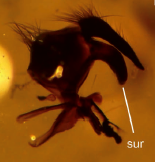 Smart Citations
Smart CitationsSee how this article has been cited at scite.ai
scite shows how a scientific paper has been cited by providing the context of the citation, a classification describing whether it supports, mentions, or contrasts the cited claim, and a label indicating in which section the citation was made.
Associations between the larval-pupal parasitoids Erycia furibunda and E. festinans (Diptera: Tachinidae) and respectively, the sympatric and syntopic butterflies Euphydryas aurinia provincialis and Melitaea cinxia (Lepidoptera: Nymphalidae)
Several studies on butterfly ecology and biology of Melitaeini butterflies have been carried out in the past, however the factors affecting butterfly mortality and the role of natural enemies on population dynamics are not yet fully known. Larval survival plays a key role in determining butterfly population size and distribution range; thus, knowing the sources and variation in larval mortality is essential understanding and predicting population dynamics. Butterfly larval mortality is generally ascribed to abiotic factors, predators and parasitoids (mainly Diptera and Hymenoptera). Among Diptera, tachinids parasitize primarily larval Lepidoptera. In this paper, we report the results of 5-year observations in the wild and captivity on the tachinids, Erycia furibunda and E. festinans, parasitoids of caterpillars of a population of Euphydryas aurinia spp. provincialis and Melitaea cinxia in Central Italy revealing their host specifity. The hosts, E. aurinia and M. cinxia, and parasitoids, E. furibunda and E. festinans, inhabit the same habitat and their life cycles highly overlap, nevertheless, the parasitoids maintain their host specifity: E. furibunda as parasitoid of E. aurinia; E. festinans as parasitoid of M. cinxia. This was confirmed by our findings during the butterfly breeding activities carried out for over five years. Although the role of chemical cues in host finding requires further research, according to our observations the presence of only E. furibunda on larval webs of E. aurinia let us suppose that the mechanism by which E. furibunda locates its host could be based on olfactory cues emitted by feeding damage to host plants that act from afar. Similarly, the mechanism of host finding used by E. festinans could act to select its host, M. cinxia. Furthermore, we illustrate some diagnostic features of adults for the identification of the studied parasitoids.
How to Cite
PAGEPress has chosen to apply the Creative Commons Attribution NonCommercial 4.0 International License (CC BY-NC 4.0) to all manuscripts to be published.

 https://doi.org/10.4081/jear.2020.8582
https://doi.org/10.4081/jear.2020.8582




